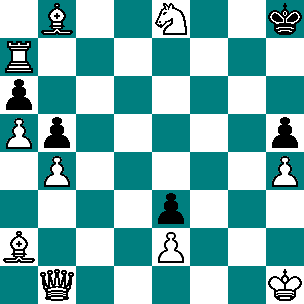If an opponent checks the enemy King repeatedly we call this perpetual check. Perpetual check is usually used by the weaker side to avoid losing the game.
Here..black is about to move his queen to checkmate the white king...
WHITE has a series of saving moves of perpetual check to cause a draw..
thus not lose the game...NOT FAIR ?? CHESS IS WAR !!

2. Stalemate
If the King is not in check but it is unable to move to a safe square we say that the King is stalemated and the game is drawn. Many beginners who are ahead on material mistakenly stalemate the enemy king. Beware! In the diagram below the Black King is not in check but it has no safe squares to go to and there is no other black piece that can move.. so the game is a draw.
(a case of too much uncontrolled power)
(a beginners mistake or a masters ploy)

When neither side has enough pieces on the board to checkmate the enemy king then the game is drawn. It is not possable to checkmate with:
- Just the two Kings on the board.
- King and Bishop against a King
- King and Knight against a King
- King and two Knights against a King
4. Repetition of moves
If the same position occurs three times in a game then a player may claim a draw. The perpetual check position above is also a draw because the same position occurs three times.(not necessarly in a row)
5. Fifty move rule
If both sides have made 50 consecutive moves without making a capture or pawn move then a player may claim a draw.
6. Draw by agreement
Both players may feel that the position on the board is equal and consequently agree to a draw. Grandmasters of relative equal streignth often end in a draw in this way.
 return site index
return site index